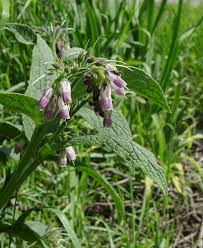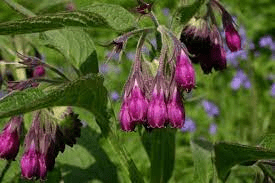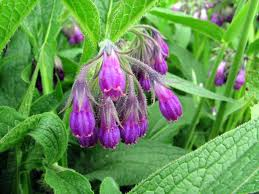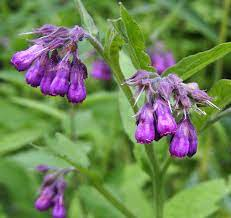Symphytum officinale, commonly known as Comfrey, is a perennial herb belonging to the Boraginaceae family. Native to Europe and parts of Asia, this robust plant has a long history of traditional medicinal use and is recognized for its potential healing properties.
However, it’s important to note that the plant contains compounds that can be toxic when ingested in large quantities, and its internal use is generally discouraged.
Morphologically, Comfrey is characterized by its hairy leaves and bell-shaped flowers that can be white, cream, pink, or purple. The plant typically grows to a height of 60 to 120 centimeters and has a deep taproot that allows it to accumulate nutrients from the soil.
Comfrey has been used in traditional medicine for centuries, with its historical applications ranging from wound healing to treating respiratory conditions.
The plant contains various bioactive compounds, including allantoin, rosmarinic acid, and tannins, which contribute to its potential therapeutic effects.
One of the primary traditional uses of Comfrey is in the topical treatment of wounds, bruises, and inflammatory conditions. Comfrey’s mucilage content is thought to have a soothing effect on the skin, promoting tissue repair and reducing inflammation.
However, it’s important to note that the internal use of Comfrey, especially in the form of teas or supplements, has been associated with liver toxicity and should be avoided.
Comfrey is also valued as a nutrient accumulator in permaculture practices. Its deep taproot allows it to access minerals from the subsoil, and when the leaves are cut and mulched, they can contribute nutrients to the surface soil.
In modern herbalism, external applications of Comfrey in the form of ointments or salves are still promoted for their potential benefits in supporting wound healing and reducing inflammation.
However, due to concerns about the internal use of Comfrey, especially in the context of its potential hepatic effects, caution is advised.
As with any herbal remedy, it is crucial to consult with healthcare professionals before using Comfrey, especially internally. The plant’s potential benefits should be weighed against its known risks, and alternative herbs with similar topical applications but lower risks may be considered.
The Botanical Description of Comfrey
1. Growth Form: Comfrey (Symphytum officinale) is a perennial herb known for its robust growth, featuring a cluster of large, hairy leaves and sturdy stems.
2. Leaves: The leaves are lance-shaped, rough to the touch, and can grow up to a foot in length. They are arranged in a spiral pattern around the stem.
3. Flowers: Comfrey produces bell-shaped flowers that vary in color from pink and mauve to purple and white. These flowers are arranged in clusters and bloom in late spring to early summer.
4. Height: Typically, comfrey plants reach a height of 2 to 3 feet, though some varieties may grow taller.
5. Root System: Comfrey boasts a deep taproot system that enables it to access nutrients from the soil, contributing to its hardiness.
6. Stem: The stem of comfrey is hairy and angular, providing structural support to the plant. It has a slightly hollow center.
7. Aroma: While not particularly fragrant, some people describe the smell of comfrey as earthy or grassy when the leaves are crushed.
8. Habitat: Comfrey is well-adapted to a variety of habitats, including meadows, gardens, and areas near rivers and streams.
9. Growing Season: Comfrey is known for its rapid growth, and it tends to flourish during the spring and early summer months.
The Geographic Distribution of Comfrey

1. Europe: Comfrey is native to Europe and has been cultivated and used for centuries in traditional herbal practices.
2. Asia: It has been introduced to various parts of Asia and is cultivated for its medicinal properties and use as a nutrient accumulator.
3. North America: Comfrey has naturalized in parts of North America, where it is often grown in gardens and permaculture systems.
4. Australia: Introduced to Australia, comfrey is found in certain regions where it has adapted to the local climate.
5. Cultivation Worldwide: Due to its versatility and benefits, comfrey is cultivated in gardens worldwide, contributing to its global presence.
6. Temperate Climates: Comfrey thrives in temperate climates and is well-suited to regions with moderate temperatures.
7. Well-Drained Soils: The plant prefers well-drained soils and is often found in areas with rich, fertile soil.
8. Sunlight Requirements: Comfrey grows well in both full sun and partial shade, making it adaptable to various environmental conditions.
The Chemical Composition of Comfrey
1. Allantoin: One of the key compounds in comfrey, allantoin contributes to the herb’s cell-proliferating and wound-healing properties.
2. Rosmarinic Acid: This antioxidant compound is found in comfrey and is known for its anti-inflammatory and antimicrobial effects.
3. Tannins: Comfrey contains tannins, which contribute to its astringent properties and may have anti-inflammatory effects.
4. Mucilage: The mucilage in comfrey gives it a slightly slippery texture and may contribute to its soothing properties.
5. Pyrrolizidine Alkaloids: While comfrey contains pyrrolizidine alkaloids, it’s essential to note that certain varieties have higher levels, raising concerns about their potential hepatotoxicity.
6. Polysaccharides: Comfrey contains polysaccharides, which may contribute to its mucilaginous properties and potential immune system benefits.
7. Phenolic Compounds: Phenolic compounds found in comfrey have antioxidant properties that protect cells from oxidative stress.
8. Essential Oils: While not as aromatic as some herbs, comfrey does contain trace amounts of essential oils that contribute to its overall chemical composition.
9. Vitamin and Mineral Content: Comfrey is a nutrient accumulator, pulling up minerals such as potassium, phosphorus, and calcium from the soil, making it a valuable addition to compost.
10. Pyrrole Derivatives: These compounds, found in certain varieties of comfrey, are associated with the plant’s potential toxic effects, emphasizing the importance of choosing low-alkaloid varieties.
11. Beta-Sitosterol: Comfrey contains beta-sitosterol, a plant sterol that may have anti-inflammatory properties and contribute to overall health.
12. Saponins: Saponins are present in comfrey and may have immune-modulating effects, though their concentration is relatively low compared to other plant sources.
Read Also: 17 Medicinal Health Benefits Of Saffron (Crocus sativus)
The Medicinal Health Benefits Of Comfrey (Symphytum officinale)

1. Wound Healing: Comfrey is renowned for its wound-healing properties, attributed to allantoin, which promotes cell proliferation and tissue repair.
2. Anti-Inflammatory Effects: Compounds like rosmarinic acid and tannins contribute to comfrey’s anti-inflammatory effects, making it useful for conditions such as arthritis.
3. Joint and Muscle Support: Comfrey has been traditionally used topically to support joint and muscle health, providing relief from strains, sprains, and bruises.
4. Bone Health: The herb’s rich mineral content, including calcium and phosphorus, supports bone health and may aid in preventing fractures.
5. Respiratory Health: Comfrey has been used historically to address respiratory issues, with its mucilage content potentially providing soothing effects.
6. Skin Conditions: Topical applications of comfrey may benefit various skin conditions, including eczema and psoriasis, thanks to its anti-inflammatory and moisturizing properties.
7. Gastrointestinal Support: Comfrey has been used to support gastrointestinal health, with mucilage potentially offering a soothing effect on the digestive tract.
8. Nutrient Accumulator: Comfrey’s deep roots enable it to accumulate nutrients from the soil, making it a valuable addition to compost and a dynamic accumulator in permaculture systems.
9. Immune Modulation: The presence of polysaccharides and saponins may contribute to comfrey’s immune-modulating effects, supporting overall immune system function.
10. Dental Health: Comfrey’s astringent properties, attributed to tannins, may contribute to its traditional use for oral health, including gum-related issues.
11. Pain Relief: Topical applications of comfrey, especially in the form of creams or ointments, may provide relief from pain associated with various conditions.
12. Anti-Aging Properties: Antioxidant compounds in comfrey, such as rosmarinic acid, may contribute to its potential anti-aging effects on the skin.
13. Urinary Tract Health: Traditionally, comfrey has been used to support urinary tract health, with its mild diuretic properties promoting kidney function.
14. Menstrual Discomfort: Comfrey’s anti-inflammatory properties may offer relief from menstrual discomfort, including cramps and bloating.
15. Stress Reduction: While not a primary use, the calming effects of comfrey may contribute to stress reduction, promoting overall well-being.
The Methods of Usage to Achieve the Provided Health Benefits Of Comfrey (Symphytum officinale)
1. Topical Comfrey Creams: For wound healing and joint/muscle support.
2. Comfrey Poultices: Localized applications for bruises or sprains.
3. Comfrey Infused Oil: Topical use for skin conditions.
4. Comfrey Tea: Internal use for respiratory health and potential digestive relief.
5. Comfrey Tinctures: Concentrated form for medicinal purposes.
6. Comfrey Capsules: Convenient daily use, following recommended dosages.
7. Comfrey Salves: Topical application for skin-related issues.
8. Comfrey Mouthwash or Rinse: Astringent properties for dental health.
9. Comfrey Compress: Soaked in comfrey-infused water for wound healing.
10. Comfrey Bath Soak: Relaxing bath addition for joint/muscle discomfort.
The Side Effects Of Using Comfrey Medicinal Plant
1. Pyrrolizidine Alkaloid Concerns: Risk of liver toxicity, especially in high-alkaloid varieties.
2. Allergic Reactions: Perform a patch test for potential allergies, particularly with topical use.
3. Internal Use Caution: Approach internal use with care due to pyrrolizidine alkaloids.
4. Photosensitivity: Topical applications may increase sensitivity to sunlight.
5. Gastrointestinal Discomfort: Excessive tea consumption may cause nausea or vomiting.
6. Pregnancy and Lactation Concerns: Avoid internal use during pregnancy and lactation.
7. Hepatotoxicity Risk: Regular monitoring for liver function is advisable.
8. Interaction with Medications: Consult healthcare professionals if taking medications.
9. Not Recommended for Pets: Avoid use in pets; consult a veterinarian for guidance.
10. Potential Irritation: Some individuals may experience skin irritation with topical use.
11. Avoidance in Liver Conditions: Not recommended for individuals with liver conditions.
12. Caution in Children: Internal use and concentrated forms should be avoided in children.
13. Not a Substitute for Professional Medical Advice: Consult healthcare professionals for specific health concerns.
Read Also: 19 Medicinal Health Benefits Of Fenugreek (Trigonella foenum-graecum)
The Scientific Research and Studies of Comfrey

1. Wound Healing Properties: Supported by studies attributing efficacy to allantoin.
2. Anti-Inflammatory Effects: Research validates comfrey’s use for conditions like arthritis.
3. Bone Healing Potential: Studies suggest potential benefits in supporting bone health.
4. Dermatological Applications: Research explores anti-inflammatory and moisturizing effects on the skin.
5. Respiratory Health Support: Limited studies indicate potential benefits for certain respiratory conditions.
6. Gastrointestinal Soothing Effects: Scientific investigations support traditional use for digestive discomfort.
7. Anti-Aging Properties: Antioxidants in comfrey have been studied for potential anti-aging effects.
8. Safety Concerns – Pyrrolizidine Alkaloids: Studies emphasize the importance of choosing low-alkaloid varieties.
9. External Use Recommendations: While internal use raises concerns, external use is often supported by scientific literature.
10. Risk Assessment in Hepatotoxicity: Studies assess the risk of hepatotoxicity, leading to cautionary recommendations.
11. Variability in Alkaloid Content: Research highlights alkaloid content variability among different comfrey varieties.
The The Safety Precautions and Recommendations In Using Comfrey Medicinal Plant
1. Choose Low-Alkaloid Varieties: Minimize pyrrolizidine alkaloid exposure by selecting specific comfrey varieties.
2. External Use Recommendations: Favor external applications such as creams and salves over internal use.
3. Patch Test for Allergies: Before widespread topical use, perform a patch test to check for potential allergies.
4. Caution in Pregnancy and Lactation: Avoid internal use during pregnancy and lactation due to potential effects.
5. Liver Condition Avoidance: Individuals with pre-existing liver conditions should avoid internal comfrey use.
6. Professional Guidance: Consult healthcare professionals, especially when considering internal use or for specific health concerns.
7. Monitor Liver Function: Regular monitoring of liver function is advisable for those using comfrey internally.
8. Interaction with Medications: Seek professional advice if using comfrey alongside prescribed medications.
9. Not Recommended for Pets: Avoid using comfrey in pets without consulting a veterinarian.
10. Children Caution: Internal use and concentrated forms of comfrey should be avoided in children; seek professional guidance.
11. Not a Substitute for Professional Medical Advice: Comfrey should not replace professional medical advice for specific health conditions.
FAQs About Comfrey Medicinal Plant
1. Is Comfrey Safe for Internal Use?
While traditionally used internally, caution is advised due to potential pyrrolizidine alkaloid content. Consult with a healthcare professional.
2. Can Comfrey Help with Arthritis?
Research suggests anti-inflammatory effects, potentially aiding conditions like arthritis. External applications are commonly used.
3. What Precautions Should Pregnant Individuals Take?
Avoid internal use during pregnancy due to potential effects. External use may be considered after consulting healthcare professionals.
4. Can Comfrey be Used for Pets?
Comfrey is not recommended for pets due to potential variations in their reactions. Consult a veterinarian for pet-specific advice.
5. How Does Comfrey Aid Wound Healing?
Allantoin in comfrey promotes cell proliferation, supporting the natural healing process of wounds.
6. Is Comfrey Safe for Children?
While topical use in moderate amounts may be considered safe, internal use and concentrated forms should be avoided in children. Seek professional advice.
7. Does Comfrey Have Anti-Aging Properties?
Antioxidants like rosmarinic acid in comfrey have been studied for potential anti-aging effects on the skin.
8. Can Comfrey be Used for Digestive Discomfort?
Traditional use suggests comfrey may offer soothing effects for digestive discomfort. Internal use should be approached with caution.
9. What is the Recommended Dosage for Comfrey?
Dosages vary based on the form of comfrey used. Follow recommended guidelines on product labels and consult healthcare professionals.
10. Can Comfrey be Used for Respiratory Conditions?
Limited studies indicate potential benefits for certain respiratory conditions, but further research is needed.
11. Are Comfrey Products Regulated?
Regulation may vary by region. Choose reputable sources, and consult healthcare professionals before using comfrey products.
12. Is Comfrey Safe for Long-Term Use?
Due to potential pyrrolizidine alkaloid concerns, long-term internal use is not recommended. Regular monitoring is advisable.
13. How Does Comfrey Contribute to Soil Health?
Comfrey is a dynamic accumulator, enriching the soil with nutrients. It is a valuable addition to compost.
14. Can Comfrey be Used for Stress Reduction?
While not a primary use, the calming effects of comfrey may contribute to stress reduction in some individuals.
15. What Should I Do if I Experience Skin Irritation?
Discontinue use and wash the affected area. If irritation persists, seek medical advice.
16. Can Comfrey Interact with Medications?
Comfrey may interact with certain medications. Consult healthcare professionals if using medications alongside comfrey.
17. Can Comfrey be Used for Urinary Tract Health?
Traditional use suggests comfrey may support urinary tract health, potentially due to mild diuretic properties.
Read Also: Sedimentation Processes in Waste-water Treatment

